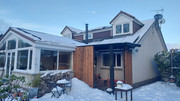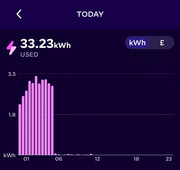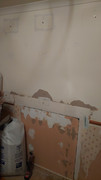Joeboy wrote: ↑Fri Jan 10, 2025 4:41 am
I use it (vermiculite) on internal walls, or walls that were once external but due to extensions are now not. Been in use in the house for about 5 years maybe 8 with absolutely no issues, only benefits. I ensured that there is an airpath upward to the vented loft so not to create a stagnant space. It has worked very well for us but as they say 'your mileage may vary'. I don't know about moisture in comparison to other products and that would be worth looking at. R value is 2.5 per inch depth. We have 2" depth in behind the plasterboard and have seen an average of 2.4 deg improvement on the walls once works were carried out. Its still only partial complete so i can compare easily. Great to see the IR thermometer shoot up on a finished surface.
Our house (timber frame, blockwork and harled walls) was built in 83 and was wildly over vented. That's the kindest way I can put it. Massive scope for improvement which we have and continue to carry out but always with an eye to moisture being able to exit the fabric via the loft and be mechanically removed in Winter in the living spaces when we can't vent with windows.
It was very nice last couple of days working away with swmbo at a sedate pace, tidying as we went and room remaining in full use (almost). Its not overly serious (like ripping the whole wall down) and we can retain the heat in property and seal off as we go. Sure, we won't achieve uber max insulation values but as said before, the house was designed and built a good few build regs revisions ago so there is a limitation in fabric design. The bit I like most is that it has shifted the heat loss calc to the better. It may be a tiny amount but its there and will stay there.

Walking into that room I can feel the difference and the wall is only 20% filled. Getting rid of the substandard cold communicating gas related gear made a huge impact.
Ita a great idea Joeboy, dont get me wrong, i am not knocking you for it, and even thought it would be good for some internal walls here that have airflow thtough them from the design of the house. With the insulated PB internally reducing access to the houses thermal mass, 50cm thick stone walls, the LECA makes sense for us in that internal wall. It wont hold heat the same as a solid brick wall, but i have perlite type beads in a "wheat bag" for my joint issues, and they do hold the heat well.
Vermiculite not as well, and is used extensively in gardening as a moisture retentive substance, hence why i mention Andy may want to think before adding it to an external wall, designed to have airflow to wick moisture away.
That said, historic scotland have many studies on their website about insulating stone walls, and studies specifically insulating behind lath and plaster.
They recommend blown cellulose, poly beads (away from wiring) or perlite.
The beads are obviously water repellant.
Blown cellulose tends to be treated with chemicals to make it water repellant.
perlite, much like LECA is blown volcanic glass, so hollow allowing water and air to pass through, rather than vermiculite, which soaks up water and expands with a tendancy to hold onto it alot longer.
With all of the above the caveat is the wall must be dry, i.e.only see occasional wet from things like sustained driving rain. A leaky gutter or bad pointing etc is guaranteed to cause issues.
Only reason i suggest LECA over perlite, is because it comes in various bead sizes, which again help to insulate but continue airflow. To my knowledge, perlite doesnt have different sizes.















